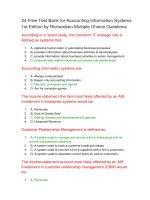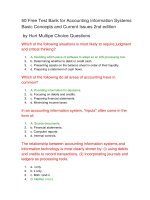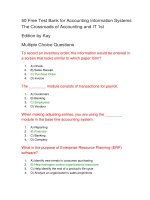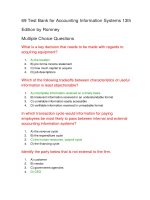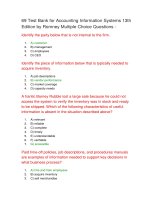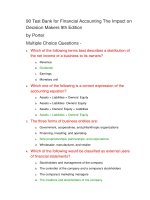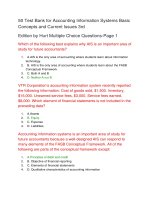90 test bank for accounting information systems the crossroads of accounting and IT 2nd edition
Bạn đang xem bản rút gọn của tài liệu. Xem và tải ngay bản đầy đủ của tài liệu tại đây (103.49 KB, 23 trang )
90 Test Bank for Accounting Information Systems The
Crossroads of Accounting and IT 2nd Edition
True False Questions
A Supply Chain Management (SCM) system is a subsystem of
an Accounting System.
1.
True
2.
False
An event that does not involve an exchange, for example
accrued interest expense, does not need to be recorded in
the accounting system.
1.
True
2.
False
Processes are related activities or events that create value.
1.
True
2.
False
Structured Query Language is used to query a relational
database.
1.
True
2.
False
The Banking Module of a baseline accounting system includes
bill paying transactions.
1.
True
2.
False
An IT audit includes auditing the System Development Life
Cycle (SDLC).
1.
True
2.
False
Accounting software often includes a navigation screen that
represents the major modules within the accounting
system.
1.
True
2.
False
A database may have two or more tables with the exact same
name.
1.
True
2.
False
An IT auditor must understand the terms and definitions used
by accounting and IT professionals.
1.
True
2.
False
The Vendors Module of a baseline accounting system relates to
the sales cycle.
1.
True
2.
False
Financial accounting focuses on providing accounting
information to internal users, primarily management.
1.
True
2.
False
Data cubes allow you to view data in two dimensions.
1.
True
2.
False
A primary key is a unique identifer for a database table.
1.
True
2.
False
Activities performed by various departments within a company
are rarely interconnected.
1.
True
2.
False
Business processes are related activities performed by an
enterprise to create value by transforming input into
output.
1.
True
2.
False
Business Intelligence tools use queries to extract data directly
from the relational database, bypassing the OLAP cube
and any accompanying delay.
1.
True
2.
False
Understanding accounting systems involves seeing the overall
system. There is no need to focus on the details.
1.
True
2.
False
An integrated enterprise system allows different departments to
use the same information.
1.
True
2.
False
The Customer Module of a baseline accounting system includes
creating purchase orders.
1.
True
2.
False
A primary key may be used to associate customer information
(name, address, phone number, etc.) with a sales order.
1.
True
2.
False
Multiple Choice Questions - Page 1
To record a payment for inventory delivered, the information
would be entered in a screen that looks similar to which
paper form?
1.
A) Sales receipt
2.
B) Check
3.
C) Invoice
4.
D) Purchase order
Which symbol is used by IT professionals to represent the
enterprise network?
1.
A) Cloud
2.
B) Star
3.
C) Circle
4.
D) Square
What is an alternative to "hard keyed" data?
1.
A) If user requirements are correctly defined, the data will not change and may be
"hard keyed."
2.
B) Using variables in the program, such as cell addresses in a spreadsheet.
3.
C) Alternatives to "hard keyed" data is not possible. All data must be "hard keyed."
4.
D) Creating the program in a way that does not require data.
What is the purpose of an onscreen entry form?
1.
A) Onscreen entry forms allow you to perform data Analysis that is cumbersome in a
relational database.
2.
B) Onscreen entry forms provide predictive modeling to gain insights from data to
improve business decisions.
3.
C) Onscreen entry forms provide a familiar interface for entering information into a
database.
4.
D) Onscreen entry forms help ensure information is entered only once in the database.
What purpose of the processing function of an enterprise
system?
1.
A) Summarize information
2.
B) Capture information
3.
C) Generate reports
4.
D) Sort and store information
The Value Chain begins with which activity?
1.
A) Selling items to customers
2.
B) Creating the products
3.
C) Purchasing items from vendors
4.
D) Providing support to customers
To record an inventory order, the information would be entered
in a screen that looks similar to which paper form?
1.
A) Sales receipt
2.
B) Check
3.
C) Invoice
4.
D) Purchase order
The sales cycle corresponds to which module in the Baseline
Accounting System?
1.
A) Banking
2.
B) Vendors
3.
C) Customers
4.
D) Employees
What is the purpose of Enterprise Resource Planning (ERP)
software?
1.
A) Help identify the end of a product's life cycle
2.
B) Identify new trends in consumer purchasing
3.
C) Analyze an organization's sales projections
4.
D) Help managers control organizational resources
Which event is part of the Sales Cycle?
1.
A) Enter time
2.
B) Make deposit
3.
C) Create purchase order
4.
D) Receive item
Which accounting software is typically used in a mid-sized
enterprise?
1.
A) Oracle's Peoplesoft Enterprise
2.
B) SAP Business One
3.
C) Peachtree
4.
D) Quickbooks Enterprise
Which of the following are NOT part of the basic functions of an
enterprise system?
1.
A) Hiring
2.
B) Output
3.
C) Input
4.
D) Processing
Which event is usually performed in the Financial modules of
the Baseline Accounting System?
1.
A) Make adjusting entries
2.
B) Pay bills
3.
C) Enter time
4.
D) Create income statement
When looking at an accounting system using the zoom view,
you see
1.
A) An enterprise-wide view of an organization showing the entire accounting system
2.
B) Information available on the tax reports for the Internal Revenue Service and other
tax agencies
3.
C) Detailed information recorded in the accounting system
4.
D) Accounting information available to internal users, primarily management
An accounting system spans which of the following Value Chain
components?
1.
A) Support
2.
B) Purchase
3.
C) Customers
4.
D) All the above except C
The three basic functions of an enterprise system are
1.
A) Input, processing, and output
2.
B) Processing, output, and reports
3.
C) Business intelligence, processing, and output
4.
D) Input, data, and reports
What modules comprise a baseline accounting system?
1.
A) Vendors, Employees, Sales, Banking, Financial, and Reports
2.
B) Inventory, Employees, Sales, Banking, Financial, and Reports
3.
C) Inventory, Employees, Sales, Banking, Accounting, and Reports
4.
D) Vendors, Employees, Customers, Banking, Financial, and Reports
Which accounting software is designed for a large-scale
company?
1.
A) Oracle's PeopleSoft Enterprise
2.
B) SAP Business All-In-One
3.
C) Oracle's JD Edwards EnterpriseOne
4.
D) SAP Business One
The Vendors module in the Baseline Accounting System
corresponds to which transaction cycle?
1.
A) Sales cycle
2.
B) Financial cycle
3.
C) Payroll cycle
4.
D) Purchasing cycle
When looking at an accounting system using the aerial view,
you see
1.
A) Detailed information recorded in the accounting system
2.
B) Information available on the tax reports for the Internal Revenue Services and other
tax agencies
3.
C) Accounting information available to internal users, primarily management
4.
D) An enterprise-wide view of an organization showing the entire accounting system
Which event is part of the Purchasing Cycle?
1.
A) Pay bill
2.
B) Create invoice
3.
C) Make deposit
4.
D) Enter bill
Which transactions are related to the purchasing cycle?
1.
A) Buying items from vendors
2.
B) Paying employees
3.
C) Selling items to customers
4.
D) None of the above
When data is "hard keyed" into the program, which of the
following is true?
1.
A) Changing the data requires recreating (recording) the entire program.
2.
B) Changing the data requires purchasing additional computer storage and may take
days or weeks.
3.
C) Changing the data is cost efficient and may be accomplished in a matter of minutes.
4.
D) Changing the data is costly and may take days or weeks.
Which transactions are usually performed in the Customers
module of the Baseline Accounting System?
1.
A) Receive inventory
2.
B) Create invoice
3.
C) Create purchase order
4.
D) Pay bills
Which transactions are related to the sales cycle?
1.
A) Paying employees
2.
B) Selling items to customers
3.
C) Buying items from vendors
4.
D) None of the above
50 Free Test Bank for Accounting Information Systems
The Crossroads of Accounting and IT 2nd Edition by
Kay Multiple Choice Questions - Page 2
Which of the following statements about data warehouses is
false?
1.
A) Data warehouses store vast amounts of enterprise data.
2.
B) Data warehouses permit extensive data analytics to provide business intelligence
tools for improved decision quality.
3.
C) Data warehouses store current and historical data.
4.
D) Data warehouses are not considered an information asset and do not need to be
safeguarded.
Spreadsheets containing data extracted from a relational
database are called what?
1.
A) Shadow data
2.
B) Ghost data
3.
C) Gray data
4.
D) Intelligent
Which of the following agents is internal to a company?
1.
A) Customer
2.
B) Employee
3.
C) Vendor
4.
D) Investor
IT ________ is the design or blueprint for an enterprise's
information technology.
1.
A) Technology
2.
B) Infrastructures
3.
C) Network
4.
D) Architecture
The staffing process occurs in which phase of the SDLC?
1.
A) Build/Buy Phase
2.
B) Deploy Phase
3.
C) Analyze Phase
4.
D) Plan Phase
Which act requires publicly traded companies to assess the
effectiveness of their internal controls and have an
independent CPA firm audit this assessment?
1.
A) Sarbanes-Oxley Act of 2002
2.
B) The GAAP Act of 1932
3.
C) Wheat Commission
4.
D) Security Exchange Commission Act of 1934
Which field below would NOT be stored in an order table?
1.
A) Customer ID
2.
B) Vendor ID
3.
C) Order ID
4.
D) ItemID
A spreadsheet can be viewed as
1.
A) A database form
2.
B) A relational database
3.
C) A flat database
4.
D) A collection of related tables
When designing a database, which field would NOT belong in a
table storing customer information?
1.
A) First Name
2.
B) Order Number
3.
C) Zip Code
4.
D) Street Address
IFRS is an acronym for
1.
A) Integrated Financial Reporting Services
2.
B) International Financial Reporting Standards
3.
C) Integrated Federal Recording Standards
4.
D) International Financial Regulated Services
A database form is a
1.
A) Database screen for data input
2.
B) Database queries
3.
C) Database screen for data output
4.
D) Database searches
When designing a database, which field would NOT belong in a
table storing inventory information?
1.
A) Cost
2.
B) Part Number
3.
C) Purchase Order
4.
D) Sale Price
What is data mining?
1.
A) A type of OLAP cube
2.
B) A method for safeguarding information asset
3.
C) A business intelligence tool
4.
D) All the above except C
In an accounting system database, which field belongs in a
table containing customer information?
1.
A) Street Address
2.
B) Cost
3.
C) Item Number
4.
D) Invoice Number
What is the purpose of Business Intelligence Technologies?
1.
A) Shadow the accounting system
2.
B) Safeguard information
3.
C) Extract data from databases
4.
D) Find consumer patterns and insights
What are the three key factors to consider for a successful
accounting system?
1.
A) People, budget, and time
2.
B) Time, processes, and technology
3.
C) People, processes, and technology
4.
D) Processes, budget, and time
Which of the following processes are performed in the
Designing Phase of the SDLC?
1.
A) Identify the new business processes
2.
B) Install the new system
3.
C) Test the new system
4.
D) Identify the new requirements for the system
Which of the following is NOT considered an information
asset?
1.
A) Shadow data systems
2.
B) Business intelligence applications
3.
C) Electronic records
4.
D) None of the above
Analyzing the impact an accounting system will have on people
should occur in which phase of the SDLC?
1.
A) Deploy
2.
B) Design
3.
C) Analyze
4.
D) Planning
The following fields are common to tables storing customer,
vendor, and employee information EXCEPT
1.
A) City
2.
B) Area Code
3.
C) Cost
4.
D) State
The following field names are part of a table for a company's
inventory. Which field name could be the primary key for
this table?
1.
A) Sales Prices
2.
B) Cost
3.
C) Item ID
4.
D) Vendor ID
In a relational database, how are tables connected?
1.
A) By a query statement
2.
B) By network addresses
3.
C) By the tables names
4.
D) By fields that are common in two or more tables
What is the purpose of security and controls over information
assets?
1.
A) Security and controls are to prevent fraud, unauthorized access, modification,
destruction, or disclosure of information assets.
2.
B) Security and controls are to prevent data analysis.
3.
C) Security and controls are to frustrate employees with legitimate need to access
information assets.
4.
D) Security and controls are to ensure all the information assets are available to all
employees.
What is the purpose of a database query?
1.
A) To search the database to answer a specific question
2.
B) To connect related tables
3.
C) To uniquely identify a record in a database table
4.
D) To provide a format for viewing data
In an accounting system database, which field belongs in a
table containing inventory information?
1.
A) Vendor ID
2.
B) Purchase Order
3.
C) City
4.
D) Invoice Number
Free Text Questions
What types of data does an operations/production system and
an accounting system need to share? How does each
system use that data?
Answer Given
An operations/production system and an accounting system would share production
employee information, work in process, and the current level of finished product. (The
student may provide additional types of data.). The operations/production system uses
the employee information to estimate production capacity. The work in process and
current level of finished product issued to calculate needed production rate. The
accounting system uses the employee data to run payroll. The work in process and
current level of finished product is used in various financial reports.
If you were the person entering transactions into an accounting
system, why would you want the input screens to look
like paper forms?
Answer Given
Input screens that mirror paper forms provide a familiar interface for entering data.
This reduces the amount of time needed to learn how to enter data and learn the
system. The familiarity also helps the user to become comfortable with the system.
What are the three vital functions an accounting system
servers? Please define each.
Answer Given
1. Storage of accounting transactions and financial data. The accounting transactions
that result from the operations of the business are typically stored in a relational
database. Sometimes the relational database that stores operational transactions is
referred to as an operational database.; 2. Business intelligence and financial analytics
for decision making. Business intelligence employs data analytics and predictive
modeling to gain insights from data to improve the quality of business decisions.; 3.
Safeguarding information assets. One of the functions of the accounting system is to
have appropriate security and controls to safeguard the information assets that it
contains.
List the transaction cycles. What type of transactions are in
each cycle?
Answer Given
- Purchasing cycle or Vendor cycle—This consists of transactions related to
purchasing items from vendors, including suppliers and consultants.; - Payroll cycle or
Expenditure cycle—This consists of transactions related to employee and payroll.; Sales cycle or Revenue cycle—This consists of transactions between the enterprise
and customers.
What are Database Forms, Database Queries, and Database
Reports? Please provide an example of each.
Answer Given
- Database Form-These are used to input data into the database. Examples are
onscreen checks and onscreen invoices. (The student may provide different
examples.); - Database Queries-These are questions. Database queries search the
database to answer a specific question and extract a specific piece of information from
one or more tables. For example, you could query the database to search on the zip
field using the criteria of zip = 54911. (The student may provide different examples.); Database Reports-Database reports provide a format for viewing the results of your
query. You can usually view a report onscreen or print out a copy of a report. For
example, a report displays the results of a query for all the expense account balances
for 2012. (The student may provide different examples.)
What is the difference between data, information, and business
intelligence?
Answer Given
Data is an individual piece of a larger entity. For example, the amount of a customer's
purchase is data. An individual piece of data is generally not helpful in making
business decisions. Information is a collection of related data. For example, an income
statement. Information provides details about what occurred in the past. Business
intelligence is an analysis of related information. For example, financial analytics and
predictive modeling. Business intelligence helps decision makers make various
predictions such as what customers will buy next year.
You are hired by a consulting company to assist in creating an
accounting system for a company that sells exclusively
online. List the fields needed for the Customer table and
the Inventory table. Identify the primary key in each table.
Answer Given
Customer table: Customer ID (primary key), First Name, Last Name, Street Address,
City, State, ZIP Code, Cell Area Code, Cell Phone, Home Area Code, Home Phone
Number, Work Area Code, Work Phone Number, Email Address, Contact Preference
(The student may have additional fields.). Inventory table: Item Number (primary key),
Item Name, Primary Vendor ID, Secondary Vendor ID, Cost, Sale Amount, Amount On
Hand, Amount On Order, Warehouse ID, Location in Warehouse (The student may
have additional fields.)
What is the difference between the aerial view and zoom view of
an accounting system?
Answer Given
The aerial view of an accounting system is the enterprise-wide view of a company
showing a global view of the entire accounting system and how information flows
through the enterprise. For example, the aerial view allows an account to see how
employee information entered in the Human Resource Management is used in
operations/productions system and the accounting system. (The student my provide a
different example.). The zoom view of accounting focuses on (drills down) specific
detailed information, events, and transactions recorded in the accounting system. For
example, closing entries. (The student may provide a different example.)
Identify the six modules in the baseline accounting system.
Which transaction cycle is associated with each module?
What type of transactions are associated with each
module?
Answer Given
- Vendor module — consists of transactions with vendors; this module relates to the
purchasing cycle.; - Customer module — consists of transactions with customers; this
module relates to the sales cycle.; - Employee module — consists of transactions with
employees for payroll; this module relates to the payroll cycle.; - Banking module —
involves cash received (deposits) and cash paid (checks/withdrawals) with the
enterprise's bank; this modules does not relate to a transaction cycle.; - Financial
module — consists of other transactions that are not part of the other modules; for
example, adjusting entries, correcting entries, and closing entries; this module relates
to the financial cycle.; - Reports module — consists of output from the Accounting
system (hard copies and soft copies); for example financial reports, tax reports, and
management reports; this module does not relate to a transaction cycle.
You are an intern at a small mom-and-pop type corner grocery
store. The owner's accountant is trying to talk the owners
into purchasing an integrated enterprise system for small
businesses. The owner thinks the accountant is just
trying find a way to charge more money. How would you
convince the owner each piece of the integrated
enterprise system would help the business?
Answer Given
The answer should include the following information: - Supply Chain Management:
items are automatically removed from inventory and calculations made for reordering
from vendors, identify fast moving items (keep reordering from vendor ) or slow
moving items (consider removing from inventory); - Customer Relationship
Management: the purchase is analyze for trends, products purchased at a particular
time of day and/or day of the week, analyze for more targeted marketing (coupons); Operations/Production System : track items from the meat counter/deli/bakery to know
when to order inputs (flour, sugar, various meat products, etc.); - Human Resources
Management: track appropriate personnel positions (more/less bakers, more/less
butchers, more/less sales clerks, more/less stockers, etc.)
How are database tables connected in a relational database?
How does this help prevent entering data multiple times?
Please provide an example.
Answer Given
Database tables in a relational database are connected by fields that are common to
two or more tables. The common field is usually the primary key for one of the tables.
This connection helps prevent entering data multiple times by associating data in one
table with data in another table. For example, customer information is usually stored in
a table (Customer) with a primary key (Customer ID) and sales order (Order)
information are stored in another table with a primary key (Order NO). By including a
field for Customer ID in the Order table, the Order table and Customer table are
connected. (The student may provide a different example.)
What types of data does a Supply Chain Management system
and an accounting system need to share? How does each
system use that data?
Answer Given
A Supply Chain Management system and an accounting system would share vendor
information (company name, primary contact, address, and phone number), items
supplied by the vendor, purchase orders, delivery dates, delivery receipt., and current
raw material inventory levels. (The student may provide additional types of data.). The
Supply Chain Management system uses this information to order more supplies and
verify delivery content. Raw material inventory levels are used to calculate when to
order more raw materials. The accounting system uses this data to know which vendor
to pay, how much to pay the vendor, and when to pay the vendor. Raw material
inventory is used in various financial reports.
How can data in an accounting information system improve
decision making? Provide examples of these decisions.
Answer Given
Data in an accounting information system can improve decision making by being
transformed into information. With further analysis, that information is transformed in to
business intelligence. Business intelligence can help a business predict what type of
new product customers will buy next year and/or what type of existing product
customers will stop buying next year. It can help a business increase sales and reduce
returns. Business intelligence can help investors decide if they should invest in the
company or sell any existing investments in company. Business intelligence can help
banks decide if they should loan the company money.
What are the advantages and disadvantages of using a shadow
data system?
Answer Given
Advantages: - Easier to perform analysis using spreadsheets; - No need to depend on
IT staff to program and run necessary queries. Disadvantages: - Spreadsheets have
very little documentation; therefore, when the individual who created it leaves, the
spreadsheet is abandoned or must be recreated; - Spreadsheets may have
inadequate on nonexistent security to prevent unauthorized access
You are an accountant and one of your clients is a small
business that sells only over the Internet. How would you
convince the owner to purchase an integrated enterprise
system?
Answer Given
The answer should include the following information: - SCM: items are automatically
removed from inventory and calculations made for reordering from vendors, identify
fast moving items (keep reordering from vendor ) or slow moving items (consider
removing from inventory); - CRM: the purchase is analyze for trends, products
purchased at a particular time of day and/or day of the week, analyze for more
targeted marketing (coupons); - Operations/Production System: track shipping
supplies; - Human Resources Planning: track appropriate personnel positions
(more/less people for gathering items in the purchase, more/less people for packaging
the purchase, more/less people in the shipping department, etc.)
What may be classified as an information asset? Please provide
an example.
Answer Given
Data contained in the information system. For example, electronic records, files, and
databases. Information technology which is defined as hardware such as computers,
servers, routers, keyboards, and monitors (the student may list other hardware) and
software such as firewalls, applications, analysis tools (the student may list other
software).
To obtain a deep understanding of the underlying business of
an enterprise system servers, you need to ask key
questions. What are those questions?
Answer Given
- How does the enterprise create value?; - What are its business operations?; - What
are the enterprise's business processes for conducting operations?; - Can the
business processes be streamlined or improved?
How does an enterprise system support people in the same
company to perform different but related business
activities? Please provide an example.
Answer Given
People within a company often need the same information to perform different tasks.
that are often interconnected. An enterprise system allows the information to be
shared throughout the company. This ensures the data used to perform the tasks are
the same. The example provided in the text is the creation of a paycheck. Human
Resources enters personal data and salary information. The accounting department
uses that information to generate a paycheck. (Students may provide a different
example.)
What is the purpose of a primary key? What would happen if a
relational database was designed without any primary
keys?
Answer Given
The purpose of a primary key is to provide a unique identifer for each record in a
relational database. If a relational database was designed without any primary keys: the same information may be entered multiple times in the database; - it would be
difficult (maybe even impossible) to connect related tables; - data retrieved may be out
of date and inaccurate
What are the three database essentials an accounting
professional needs to know? Define and provide an
example of each.
Answer Given
Field - A piece of information about events, people, or objects. Example, phone
number. (The student may provide a different example. Record - A collection of related
fields. Example, customer ID, first name, last name, street address, city, state, zip
code, area code, and phone number. (The student may provide a different example.)
Table - A collection of related records with a unique table name. For example,
Customer. ( The student may provide a different example.)
